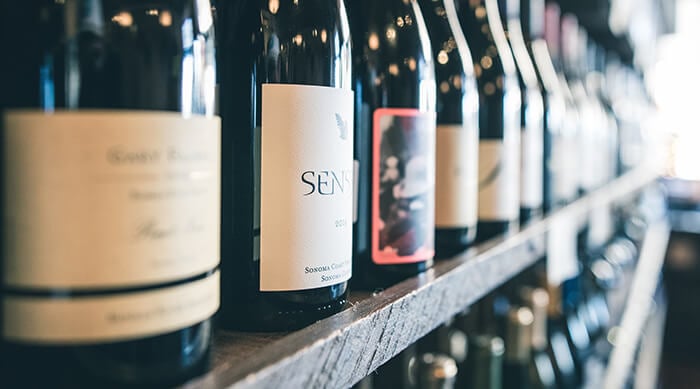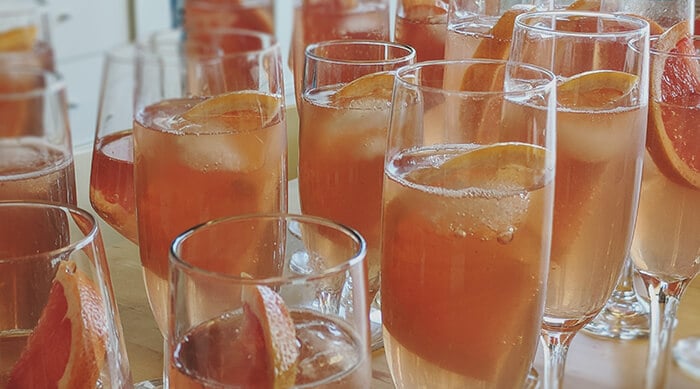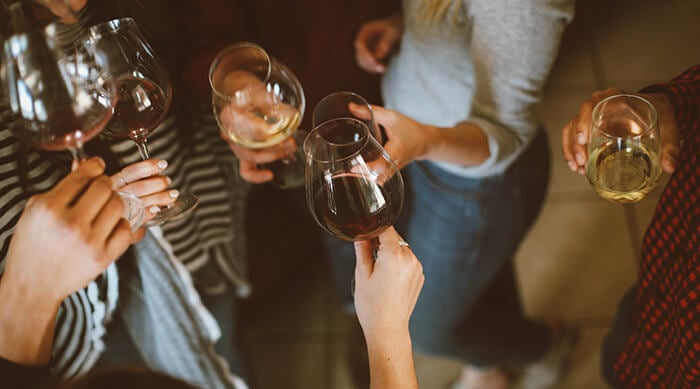There is absolutely nothing wrong with choosing a bottle of wine based on an eye-catching label. Maybe that’s a celebrity endorsement, a whimsical illustration, or a shoutout to a wine region that you’ve visited and loved.
If you want to dig a little deeper into the intricacies of a wine, though, there’s so much information available right there on the label.
What are the most important parts of a wine label? The most important parts of a wine label are the information around the wine type and the origin of the wine. That will give you the best idea about what’s inside that bottle and what to expect when you taste wine.
That’s certainly not the only information you should pay attention to, especially if you have different priorities. Use our guide to learn how to read a wine label like the expert that you are — or want to be.
Table of Contents
Front Label
1. Wine Producer or Brand Name
Required
The wine producer or brand name tells you who made the wine. There’s no set way to offer this information. Some European wine brands prefer to keep things a little under the radar in a smaller font at the top or bottom of the label.
Some American wine brands like their brand name front and center in a recognizable script. If you’re looking at a label without a brand name, turn the bottle around for the bottler name on the back label.
2. Appellation
Required (in certain circumstances)
If you’re drinking wine with sommelier-level wine fans, a wine’s appellation is one of the most important pieces of information on a wine label.
Appellation describes where the grapes in a bottle came from and defines production requirements for that wine. It also suggests climate and geographical features of a wine region.
An American Viticultural Area (AVA) is a type of appellation used for American wines. California alone has over 130 unique AVAs, including Napa Valley.
The most famous example of an appellation is probably Champagne. While the word is often used to describe any sparkling wine these days, you’re technically only drinking Champagne if it comes from the Champagne region of France.
Makers of true Champagne have to follow a set of rules and vineyard practices to bottle and sell under that appellation.
If you see “Grand cru” on a label, that means you’re looking at a wine with the highest designation through the Appellation d'Origine Contrôlée (AOC). That’s the governing body that handles wines made in the Burgundy and Alsace regions in France.
3. Varietal
Required
The varietal on a wine label describes the grape variety used in that bottle of wine. This goes beyond a red wine or a white wine into the specific grapes used by that winemaker.
If you’ve been diligent with your wine tastings and prefer a full-bodied malbec over a lighter pinot noir, look for labels that showcase those grapes. The thing is, you won’t always see the grape varietal on a wine label.
Some winemakers use shorthand for blends, like GSM (grenach, syrah, Mourvèdre) out of the Cotes du Rhône region in France. You might see a percentage for each grape in popular blends to give you an idea of the dominant grape, but that’s not always the case.
Other labels may only give you the type of wine, like a red table wine. In the case of higher quality wines out of Old World winemaking regions, winemakers may operate on the assumption that you know what you’re getting by region alone.
4. Alcohol Content
Required (in certain circumstances)
Federal law states that a wine label must include the alcohol content if it has an alcohol by volume (ABV) over 14%. It’s legal for an ABV to fall in a range plus or minus up to 1.5 percentage points for wines at or below that threshold.
Many wines fall below that ABV anyway. A light riesling may only have an alcohol content of around 8%. Rosé wines come in around 12%.
Wines below 14% might just include a generic “light wine” or “table wine” on the label, but it’s more likely you’ll still see the ABV even below that number. Winemakers want to make sure they meet export requirements if they sell their wines in countries with more strict requirements.
It’s also important for consumers to know how boozy a wine is, especially if they want to moderate their drinking. (A non-alcoholic wine is a great idea if that sounds like you!) A higher ABV typically means more calories, too.
5. Vintage
Optional
What does the date on a wine label mean? The date on a wine label is the date on which the grapes were harvested.
If you’re sipping on a cabernet sauvignon from 2019, that means the grapes for that wine were harvested in 2019. From there, a winemaker might hold onto the highest quality bottle of wine for aging purposes, but the vintage, or harvesting date, doesn’t change.
There’s some flexibility when it comes to vintage, but most high-quality AVA wines require that 95% of the grapes in those wines fall under the vintage on a label. A non-vintage wine isn’t necessarily a bad wine. It just means the grapes were harvested from different years.
A wine’s vintage date is more important with high-quality wines. If you’re looking for a bottle for a casual dinner party, we promise your guests won’t notice whether that merlot is from the current year or the year before.
A very good year for one grower may have been a terrible year for another, by the way. Things like weather and issues with harvesting won’t show up on a label but can affect the taste of your wine.
6. Vineyard Designation
Optional
A vineyard designation on a wine label means that the wine comes from one single vineyard featured on the label. This might be the same as the brand highlighted on a label, but that’s not always the case with the larger wine brands.
It’s also sometimes used as a suggestion from a winemaker that you’re about to pick up a higher-quality wine. Vineyard designations have to be official. That means if you looked up a map of vineyards in a wine-growing region, you’d find that vineyard designation.
7. Special Designation
Optional
Some winemakers add information to a wine label that isn’t necessary but suggests a high-quality sipping experience. That isn’t always the case, and can be a bit of a marketing ploy. The idea of a “reserve” wine is a good example of this.
Wineries that use old vines in Italy use the word “riserva” to describe extra aging. An Italian wine like Chianti under the “riserva” label is considered a superior Chianti over anything else on the shelf. The same is true of a reserva Rioja from Spain.
The term isn’t as regulated in the United States, so it doesn’t hold the same meaning.
That vintner’s reserve from your favorite Oregon winery may not be any different from a cheaper bottle on their wine list. On the flip side, it might be a wine that used the best grapes from that vintage. It can be hard to tell.
8. “Estate Bottled”
Optional
If a wine is made from grapes grown in a vineyard owned or controlled by that winery, you may see “estate grown,” “estate bottled,” or “ grown, produced, and bottled by” on the label. That means the winery has control over every step of the winemaking process on their own property.
9. Wine Name
Optional
A wine’s name is basically a marketing tool. Some wineries give wines from the same grape varietal unique names to differentiate them based on vintage. Others won’t give their wines a name at all and rely on the varietal and brand name itself.
Wine names are meant to be eye-catching or add a personal touch to a bottle of wine, but they don’t signal whether a wine is low- or high-quality. A winemaker may just want to make a batch in tribute of their favorite pet or middle school art teacher. It won’t affect the wine itself.
Back Label
10. Producer and Bottler
Required
The producer and bottler on the back of a bottle tell you more about how that wine was made. We’ve already talked about estate bottled wines, but there are a few more layers to that concept.
What does the term "bottled by" mean on a wine label? The term “bottled by” on a wine label refers to the winemaker or brand that bottled the wine.
Sometimes winemakers outsource certain aspects of the process, including bottling. That doesn’t mean a wine is bad. A winery may focus on growing quality grapes, but leave the bottling to someone else.
If you see “produced and bottled by” on a label, that means at least 75% of that wine was made at that address. That covers more than just the bottling process.
11. Government Warnings
Required
The wording might differ based on the country of origin, but every bottle of wine comes with a government warning. In the United States, warnings define the dangers of drinking and driving, drinking while pregnant, and possible health problems associated with heavy drinking.
12. Net Bottle Contents
Required
The net contents describes the amount of wine in a bottle. The standard size is 750ml, or 5 standard glasses of wine per bottle. Half-bottles (375 ml) and magnums (1.5 L) are also pretty easy to find, but anything smaller and larger is more of a novelty.
If you don’t see the net contents right on the label, it might be blown onto the glass of the bottle itself in raised type.
13. Sulfites Declaration
Required (in certain circumstances)
Let’s get one thing out of the way first: Every wine contains sulfites. They occur naturally as part of the fermentation process, so there’s really no such thing as a sulfite-free wine. They’re also in foods like dried fruit, pickled veggies, jams, and pizza doughs, too.
If you see a wine with “CONTAINS SULFITES” on the label, that means the wine includes sulfites at 10 or more parts per million (ppm). That’s a federal requirement and the only thing approaching nutrition facts on most wine labels.
For wine drinkers who want fewer sulfites because they have a true sulfite allergy, low-sugar red wines high in tannins are usually lower in sulfites. White wines with a high acidity like sauvignon blanc have fewer sulfites than sweet white wines.
Read Next: How Long Does Unopened Wine Last?
Old World vs. New World Wine Labels
If you’re a wine beginner, Old World wines are some of the most confusing labels to navigate in a wine shop. You’re less likely to see wineries, brands, and even varietals on labels and more likely to see appellations.
Burgundy wines, for example, refer to the region, not the grape. Red Burgundy wines are made of pinot noir grapes. White Burgundy wines are made of chardonnay grapes. Winemakers from those regions tend to assume you know this already if you’re buying a Burgundy wine.
New World wines are wines from places like North America and Australia that didn’t “invent” wine. These labels are big on wine names, varietals, and often a less serious approach. That doesn’t make them low-quality, even if they seem less traditional.
Happy Hunting!
There you have it! Now you can shop for wines like a pro. If you’re just getting into wine, take notes on what you like, paying attention the producers, appellations, and varietals you love. Maybe you’ll get a taste for one vineyard’s grapes and know to look for them next time.
If all you’re looking for is the best non-alcoholic wine, there’s only one thing to pay attention to on a wine label: the Surely brand. We like to say we’re part of the new New World of wine for anyone who wants to enjoy a glass without the negative effects of conventional wines.
If you love a fruit-forward red, try our non-alcoholic pinot noir. Take your wine and celebrations to-go with our canned sparkling Brut.


![Wine Storage Temperatures [Basics + Best Practices]](https://dropinblog.net/cdn-cgi/image/fit=scale-down,width=700/34240221/files/featured/Wine_Storage_Temp.jpg)

